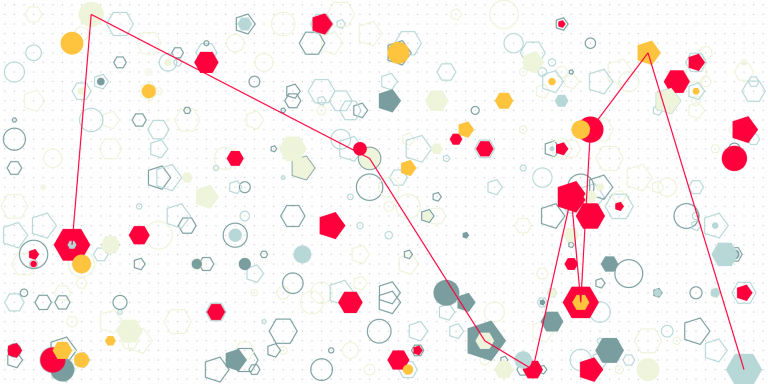How New Ideas Use Old Terms

One of the observations made in the discussion of conceptual leaps is that new ideas rely on old. Even if new ideas mark discontinuity with old, they also built on old ideas. By old ideas, I mean ideas which are established, non-controversial for a given group of people working together (so they may be controversial outside that group, they do not need to be universally non-controversial – if that’s even achievable). What does it mean exactly that new ideas rely on the old? How can we clearly show this? This is the topic of the present text.

Consider an example: How do you explain a satellite to a child? Here are two definitions that you could rely on.
Satellite (OED definition): ”An artificial body placed in orbit around the earth or moon or another planet in order to collect information or for communication.” [1]
Satellite (Wikipedia definition): ”In the context of spaceflight, a satellite is an artificial object which has been intentionally placed into orbit. Such objects are sometimes called artificial satellites to distinguish them from natural satellites such as Earth’s Moon.” [2]
If the child already has an idea of artificial bodies, orbit, earth, planet, of what collecting information and communication are about in relation to these notions, then the first definition might be a good start. It is not an explanation, but we will come back later to the differences between definitions and explanations.
How about this, which NASA says is for children ages 10+?
”A satellite is a moon, planet or machine that orbits a planet or star. For example, Earth is a satellite because it orbits the sun. Likewise, the moon is a satellite because it orbits Earth. Usually, the word ”satellite” refers to a machine that is launched into space and moves around Earth or another body in space.” [3]
Or the following version, from NASA too, for a younger audience.
”A satellite is an object that moves around a larger object. Earth is a satellite because it moves around the sun. The moon is a satellite because it moves around Earth. Earth and the moon are called ”natural” satellites. But usually when someone says ”satellite,” they are talking about a ”man-made” satellite. Man-made satellites are machines made by people. These machines are launched into space and orbit Earth or another body in space.” [4]
If you had to choose one, which one would it be? Are either of the first two good candidates?
You can think of these questions by looking at definitions backwards, from the definiens which defines or explains, to the definiendum, i.e., the term being defined.
Take the Wikipedia Satellite definition again. Notice it mentions the term ”context”, a complicated term. Context is an abstraction that bears multiple precise definitions, which are likely to vary across specific disciplines; i.e., context has a different definition in different technical languages. For example, Wikipedia gives this, for ”context” in computer science:
Context (Wikipedia definition, computer science): ”In computer science, a task context is the minimal set of data used by a task (which may be a process or thread) that must be saved to allow a task to be interrupted, and later continued from the same point.” [5]
This is certainly not a unique or conventional understanding of the notion of context in computer science altogether. There are specific, and substantially different definitions of context in, e.g., knowledge representation, requirements engineering, mobile computing, and so on. Here is a definition from mobile computing research.
Context (mobile computing): ”Context is any information that can be used to characterize the situation of an entity. An entity is a person, place, or object that is considered relevant to the interaction between a user and an application, including the user and applications themselves.” [6]
In short, context has a definition that varies between technical languages. In philosophy, the relationship between context and knowledge is an ongoing and longstanding debate [7].
Oxford English Dictionaries give the following generalist definition.
Context (OED definition): ”The circumstances that form the setting for an event, statement, or idea, and in terms of which it can be fully understood.” [8]
Being twisted in this way, ”context” is not a term to use lightly, when explaining ”satellite” to children.
The important takeaway here is not that it is hard to explain a satellite to a child, but this: how you define a term depends on two things, namely what you assume the user of that definition already knows, and what they may want to do, once they learn the definition or explanation you give them.
You may, sometimes in error, assume that the child does not know enough for you to use the Oxford English Dictionary definition. If you also think the child needs it simply out of curiosity, then perhaps either of the two NASA definitions will do.
But what if an astrophysicist asks an engineer for a definition of ”satellite”, not out of curiosity, but because they are working together on the design of a new satellite, and they are trying to align their ideas. None of the definitions above might work; perhaps their definition would speak of gravitationally bound objects in orbits, or use other technical terms more appropriate to their background knowledge and the task at hand.
This gets us to the second and third takeaways
- it makes little sense to think about one term and its definition in isolation from everything else, and
- a technical language leans on natural language to some extent, even if only by using terms from natural language in definitions of technical terms.
The following illustrates how the Satellite definition from the Oxford English Dictionary presumably leans on other natural language terms. Some are emphasized below.
Satellite (OED definition, emphasis added): ”An artificial body placed in orbit round the earth or moon or another planet in order to collect information or for communication.” [1]
But that definition of Satellite is taken from the Oxford English Dictionary, so by design, it leans on other words from there, i.e., on how these other words are defined there.
Let’s take a different example now, where some words in the definiens are not in the Oxford English Dictionary at the time of writing.
Biosafety (UNDP definition): ”The prevention of large-scale loss of biological integrity, focusing both on ecological and human health. Set of measures or actions addressing the safety aspects related to the application of biotechnologies and to the release into the environment of transgenic plants and organisms, particularly microorganisms, that could negatively affect plant genetic resources, plant, animal or human health, or the environment.” [9]
To summarize, in the Biosafety definition above, there are two terms outside natural language and outside the glossary itself: ”large-scale loss” and ”biological integrity”, and only ”Biosafety” is itself defined in the glossary, no other term from the definiens is.
Is that a good definition?
This is hard to say, as ”good definition” itself is an open topic see texts on theories of definition, recalling ideas from Kant, Belnap, Kripke. It is clear, however, that there are several things to think about here:
- ”Biosafety” is defined independently from the rest of the glossary,
- ”Large-scale loss” is undefined within the topic of the glossary, i.e., the glossary does not help reduce the vagueness of that term in any way, and ”Biological integrity” is undefined in the glossary, and since it is not part of natural language, the authors in the glossary must have leaned on a technical language, but did not point to it in the glossary.
If these look like details, they are not. Here is a sample of the activity around getting to and agreeing on a technical definition of ”biological integrity”:
”[United States Environmental Protection Agency] convened a symposium […] on the integrity of water soon after passage of PL 92-500 [Federal Water Pollution Control Act], but no clear definition of biotic integrity emerged. Many authors advocated the use of a holistic perspective. Karr and Dudley […] argued that the ”integrity” objective encompasses all factors affecting the ecosystem and developed a now widely quoted definition of biological integrity as the ability to support and maintain ’a balanced, integrated, adaptive community of organisms having a species composition, diversity, and functional organization comparable to that of natural habitat of the region.’ A more recent paper defined ecological health (an umbrella goal, the maintenance of which motivates virtually all environmental legislation) as follows: ’a biological system…can be considered healthy when its inherent potential is realized, its condition is stable, its capacity for self-repair when perturbed is preserved, and minimal external support for management is needed’[…].” [10]
Disagreement is common when specialists work on definitions. The problem is not disagreement, but disconnect, which happens if the discussion involves parallel monologues, each pushing its own definition, and no dialogue where there is convergence to an agreement on the definition of each debated term.
Going back to takeaways, these examples illustrate how a definition, even of a new technical term, depends on natural language and therefore of old terms and their readings accepted as part of natural language, however unclear they may be. As long as your technical language leans on natural language, which is not bad in itself, you are building something that is intended to be more precise, accurate, and clear from pieces which may not be that at all. In the worst case, you are simply changing where vagueness, ambiguity, and other deficiencies are coming from.
New ideas need new words. At the same time, new words are anchored in old ones. As words represent ideas, new ideas are rooted in old.
References
- Satellite | Definition of Satellite in English by Oxford Dictionaries. url: http://en.oxforddictionaries.com/definition/satellite
- Wikipedia – Satellite. url: http://en.wikipedia.org/wiki/Satellite
- NASA Knows! (Grades 5-8) – What Is a Satellite? url: http://www.nasa.gov/audience/forstudents/5-8/features/nasa-knows/what-is-a-satellite-58.html
- NASA Knows! (Grades K-4) – What Is a Satellite? url: http://www.nasa.gov/audience/forstudents/k-4/stories/nasa-knows/what-is-a-satellite-k4.html
- Wikipedia – Context (Computing). url: http://en.wikipedia.org/wiki/Context_(computing)
- Gregory D Abowd et al. “Towards a better understanding of context and context-awareness”. In: International symposium on handheld and ubiquitous computing. Springer. 1999, pp. 304–307.
- Patrick Rysiew. “Epistemic Contextualism”. In: Stanford Encyclopedia of Philosophy. Stanford University, 2017. url: http://plato.stanford.edu/entries/contextualism-epistemology/
- Context | Definition of Context in English by Oxford Dictionaries. url: http://en.oxforddictionaries.com/definition/context
- United Nations Development Programme Glossary. url: http://www.sdfinance.undp.org/content/sdfinance/en/home/glossary.html
- James R Karr. “Biological integrity: a long-neglected aspect of water resource management”. In: Ecological applications 1.1 (1991), pp. 66–84.




